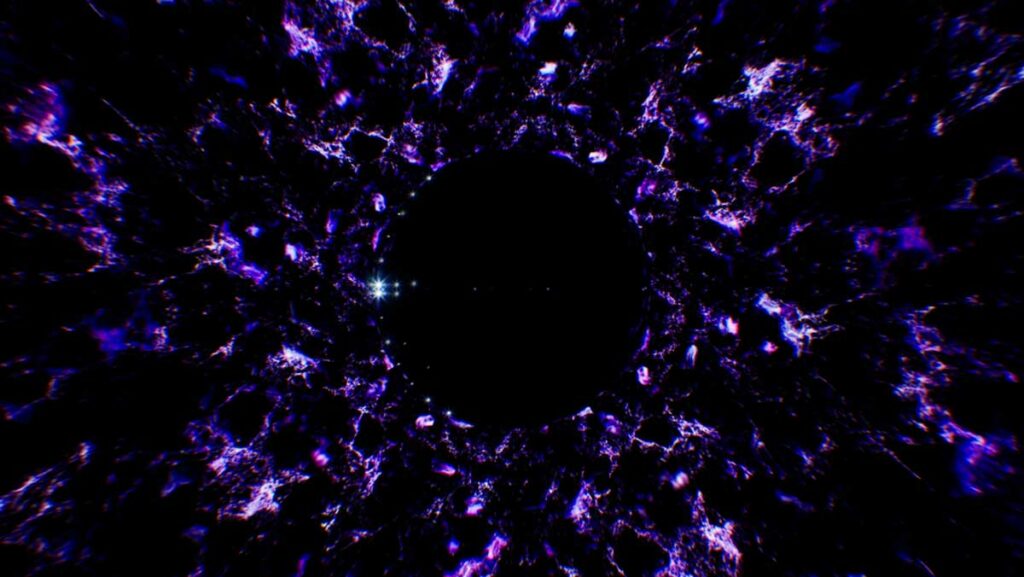Dark matter has long fascinated scientists and astronomers as one of the greatest mysteries of the universe. It is an enigmatic substance that cannot be directly observed or interacted with through electromagnetic radiation. Yet, its existence is inferred from its gravitational effects on visible matter. In this comprehensive article, we will delve into the depths of the cosmos and explore the intriguing concept of dark matter. What exactly is dark matter in the universe? Join us on this cosmic journey as we unravel the mysteries and shed light on this captivating phenomenon.
Understanding Dark Matter
What is Dark Matter?
Dark matter is a form of matter that does not emit, absorb, or reflect light, making it invisible to conventional telescopes and other instruments. Its presence can only be inferred through its gravitational effects on visible matter. While we cannot directly observe dark matter, its existence is supported by a wealth of observational and theoretical evidence.
Dark Matter in the Universe
Dark matter is believed to be ubiquitous in the universe, comprising a significant portion of its total mass. In fact, observations suggest that dark matter makes up about 85% of the matter content in the cosmos, with the remaining 15% composed of ordinary, or baryonic, matter.
Properties of Dark Matter
Dark matter possesses several intriguing properties that distinguish it from ordinary matter. Firstly, it is non-baryonic, meaning it is not composed of protons, neutrons, or electrons. Instead, scientists hypothesize that dark matter consists of different particles yet to be discovered.
Secondly, dark matter is characterized by its weak interactions with both itself and ordinary matter. Unlike ordinary matter, which interacts through electromagnetic and nuclear forces, dark matter interacts primarily through gravity. This weak interaction makes it challenging to directly detect and study dark matter particles in laboratory experiments.

The Discovery of Dark Matter
Early Observations
The existence of dark matter was first proposed in the 1930s by Swiss astronomer Fritz Zwicky. Zwicky’s observations of the Coma Cluster, a large group of galaxies, revealed that the visible mass alone could not account for the high speeds at which the galaxies were moving. He hypothesized the presence of an invisible “dark” component responsible for the observed gravitational effects.
Rotation Curves of Galaxies
Further evidence for dark matter emerged in the 1970s when astronomer Vera Rubin and her colleagues studied the rotation curves of galaxies. They found that the orbital velocities of stars in the outer regions of galaxies remained constant or increased, contrary to what would be expected based on the visible mass distribution. This discrepancy indicated the presence of additional mass, or dark matter, in the outskirts of galaxies.
Cosmic Microwave Background Radiation
The study of the cosmic microwave background radiation (CMB) has also provided crucial evidence for the existence of dark matter. The CMB is the faint afterglow of the Big Bang, and its detailed measurements have revealed patterns in the distribution of matter and energy in the early universe. These patterns align with predictions based on the presence of dark matter, further supporting its existence.

The Role of Dark Matter in the Universe
Gravitational Effects of Dark Matter
Dark matter’s primary influence on the universe is through its gravitational effects. Its mass contributes to the overall gravitational field, shaping the distribution of visible matter and influencing the formation and evolution of galaxies, galaxy clusters, and large-scale cosmic structures.
Dark Matter and Galaxy Formation
Dark matter played a crucial role in the formation of galaxies. In the early universe, regions of higher dark matter density acted as gravitational seeds, attracting ordinary matter and facilitating the collapse and formation of galaxies. As galaxies formed, dark matter continued to provide the gravitational scaffolding necessary to hold them together.
Dark Matter and the Large-Scale Structure of the Universe
On even larger scales, dark matter is responsible for the cosmic web-like structure that permeates the universe. Over billions of years, dark matter’s gravitational pull caused ordinary matter to clump together, forming galaxy clusters, superclusters, and vast voids in between. This intricate cosmic web serves as a roadmap to the distribution of matter on the largest scales.
Candidates for Dark Matter
Scientists have put forth several hypotheses regarding the nature of dark matter particles. While the exact identity of dark matter remains unknown, some of the leading candidates include:
Weakly Interacting Massive Particles (WIMPs)
WIMPs are hypothetical particles that interact weakly with ordinary matter and possess a mass several times that of a proton. They were proposed as a potential explanation for dark matter due to their predicted properties and their compatibility with particle physics theories such as supersymmetry.
Axions
Axions are another class of hypothetical particles that could account for dark matter. They were initially proposed to solve a different problem in particle physics but have also been considered as potential dark matter candidates due to their unique properties and predicted abundance.
Read Also: New Study sheds light on axion dark matter
Other Hypothetical Particles
In addition to WIMPs and axions, scientists have proposed various other hypothetical particles as potential dark matter candidates. These include sterile neutrinos, gravitinos, and more. Research and experiments are ongoing to search for these particles and determine if they could indeed constitute dark matter.
The Search for Dark Matter
Underground Experiments
To detect dark matter particles, scientists have constructed sensitive detectors deep underground to shield against background radiation. These experiments aim to capture the rare interactions between dark matter particles and ordinary matter. Examples of such experiments include the XENON1T and LZ experiments, which use liquid xenon as a detection medium.
Particle Accelerators
Particle accelerators, such as the Large Hadron Collider (LHC), also contribute to the search for dark matter. These powerful machines accelerate particles to high energies and recreate conditions similar to the early universe. By smashing particles together, scientists hope to produce and detect dark matter particles indirectly.
Dark Matter Annihilation and Detection
Another approach to detecting dark matter is through the observation of its annihilation products. If dark matter particles can self-annihilate, they may produce detectable signals of high-energy particles, such as gamma rays or cosmic rays. Astronomical observatories, such as the Fermi Gamma-ray Space Telescope, are involved in searching for such signals.
The Current State of Dark Matter Research
Dark Matter and Cosmology
Dark matter continues to be an active area of research, with scientists combining observations from cosmology, particle physics, and astrophysics to gain a deeper understanding. Cosmological simulations and large-scale surveys, such as the Dark Energy Survey and the Euclid mission, aim to map the distribution of dark matter and provide insights into its properties.
Future Directions and Challenges
While progress has been made in understanding dark matter, many questions and challenges remain. The precise nature of dark matter particles, their interactions, and their role in galaxy formation and evolution are still subjects of intense investigation. Future experiments, observatories, and theoretical advancements will continue to shed light on this mysterious cosmic ingredient.
Conclusion
Dark matter stands as a captivating enigma that permeates the fabric of the universe. Its invisible presence shapes the cosmos, influencing the formation of galaxies, sculpting the large-scale structure of the universe, and leaving its imprint on the cosmic microwave background radiation. While much remains to be discovered about dark matter, ongoing research and advancements in technology bring us closer to unraveling its secrets and expanding our understanding of the universe’s hidden mysteries.
FAQs
There are several lines of evidence that support the existence of dark matter. Some of the key pieces of evidence include the observation of galaxy rotation curves, the gravitational lensing effect, and the distribution of cosmic microwave background radiation.
Dark matter itself cannot be directly observed since it does not interact with light or other forms of electromagnetic radiation. However, its presence can be inferred through its gravitational effects on visible matter and its influence on the large-scale structure of the universe.
Dark matter exerts a gravitational force on galaxies, causing them to rotate at higher speeds than what would be expected based on the visible matter alone. This discrepancy in rotational velocity provides evidence for the presence of dark matter.
Dark matter and dark energy are two distinct but equally mysterious components of the universe. While dark matter is believed to contribute to the gravitational mass of galaxies and galaxy clusters, dark energy is thought to be responsible for the accelerating expansion of the universe.
Dark matter does not interact significantly with regular matter, so it is unlikely to have any direct harmful effects on us or our immediate environment. Its influence is primarily felt on cosmic scales and in the dynamics of galaxies and the large-scale structure of the universe.
Dark matter is believed to have been present since the early stages of the universe. It is thought to have formed through various processes in the early universe, and it is not known to be created or destroyed under normal circumstances.
Dark matter interacts with regular matter only through the force of gravity. It does not interact through electromagnetism, the strong nuclear force, or the weak nuclear force, which are the fundamental forces responsible for interactions between particles in the standard model of particle physics.
While dark matter is the most widely accepted explanation for the observed gravitational effects in the universe, there are alternative theories that attempt to explain these phenomena without invoking the existence of dark matter. Some of these alternative theories include modifications to the laws of gravity, such as Modified Newtonian Dynamics (MOND).
The presence of dark matter is intimately connected to the Big Bang theory and the early evolution of the universe. As the universe expanded and cooled after the Big Bang, it is believed that dark matter began to form and clump together, eventually leading to the formation of galaxies and other large-scale structures.
Dark matter is thought to be distributed in a web-like structure known as the cosmic web, with denser regions called dark matter halos. However, it is not evenly distributed, and its distribution is influenced by the gravitational pull of visible matter.
Dark matter represents a significant piece of the puzzle when it comes to understanding the nature of the universe. By studying its properties and effects, scientists hope to gain insights into the fundamental particles and forces that govern the cosmos.
If dark matter were not to be found through future experiments or observations, it would require a significant reevaluation of our current understanding of gravity and the formation of galaxies. It would challenge our existing models and theories and open the door to new and alternative explanations.
When galaxies collide, the gravitational effects of dark matter play a crucial role in shaping the dynamics of the interaction. Dark matter halos can pass through each other relatively unaffected, while the visible matter in the galaxies interacts more strongly, leading to the formation of new structures and the redistribution of mass.
Yes, there are numerous ongoing experiments and projects dedicated to detecting dark matter. These include underground experiments, such as the Large Underground Xenon (LUX) and the Cryogenic Dark Matter Search (CDMS), as well as particle accelerators like the Large Hadron Collider (LHC).
While dark matter may not have direct implications for everyday life, its study and understanding contribute to our knowledge of the universe and the forces that shape it. Furthermore, advancements in scientific research, driven by the curiosity surrounding dark matter, often lead to technological innovations and breakthroughs that can benefit society as a whole.

